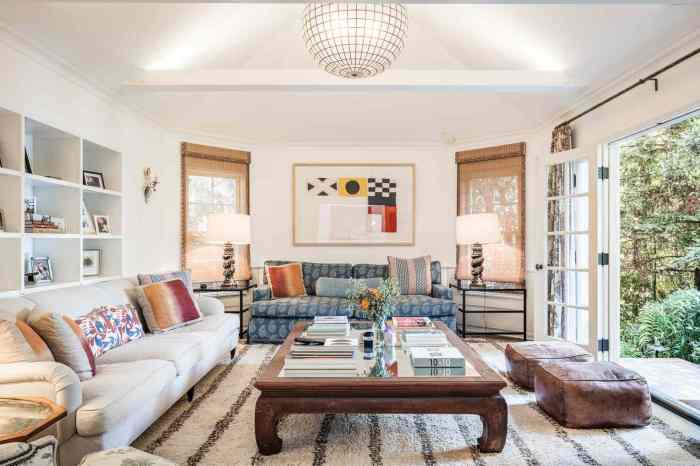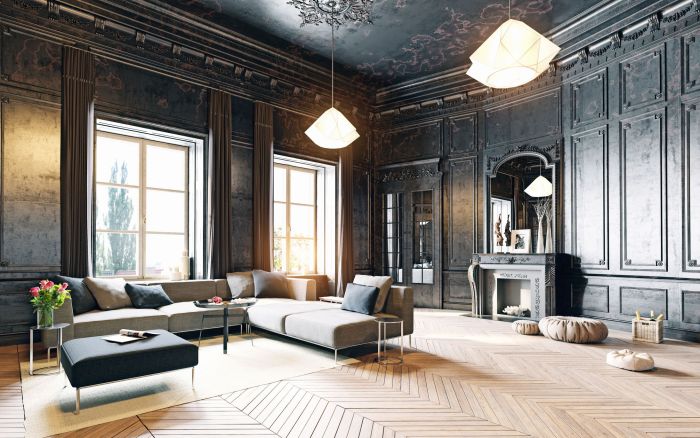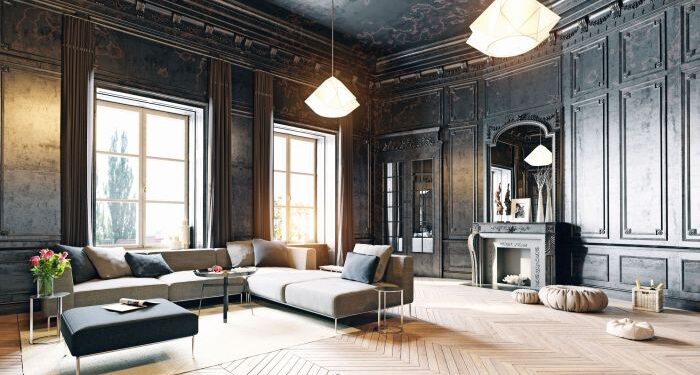Delving into the art of blending vintage and modern interior aesthetics opens up a world of creativity and style. By understanding the key elements and tips for achieving balance, you can create a space that seamlessly merges the charm of the past with the sleekness of the present.
Exploring the nuances of vintage and modern design, this guide offers practical advice on incorporating different styles, textures, and materials to craft a timeless and visually appealing interior.
Understanding Vintage and Modern Aesthetics
Vintage interior design is characterized by elements from previous eras, typically ranging from the 1920s to the 1960s. It often includes ornate details, intricate patterns, and antique furniture pieces that add a sense of nostalgia and history to a space.Modern interior design, on the other hand, focuses on clean lines, minimalism, and functionality.
It incorporates sleek furniture, neutral color palettes, and an emphasis on open spaces to create a contemporary and streamlined look.
Key Elements of Vintage Interior Design
- Antique furniture pieces such as claw-footed tables, wingback chairs, and ornate mirrors.
- Rich and warm color palettes like deep reds, browns, and golds to create a cozy atmosphere.
- Intricate patterns in textiles like floral prints, damasks, and paisleys to add visual interest.
- Decorative accessories like vintage clocks, porcelain figurines, and crystal chandeliers to enhance the nostalgic feel.
Key Elements of Modern Interior Design
- Clean lines and geometric shapes in furniture and architectural details for a sleek and minimalist look.
- Neutral color schemes with pops of bold colors or metallic accents for a contemporary touch.
- Open floor plans and multi-functional spaces to promote a sense of airiness and simplicity.
- Use of materials like glass, steel, and concrete to add a modern and industrial flair to the design.
Finding the Balance

When mixing vintage and modern aesthetics in interior design, finding the right balance is crucial to create a cohesive and harmonious space. It's important to ensure that one style does not overpower the other, but instead, they complement each other to achieve a unique and balanced look.
Harmonious Blend of Vintage and Modern Elements
To achieve a harmonious blend of vintage and modern elements, consider incorporating key pieces from each style that share similar characteristics or colors. For example, pairing a sleek modern sofa with a vintage rug or adding retro accessories to a contemporary room can create a visually appealing contrast.
Mixing different textures such as smooth leather with rustic wood can also help in achieving balance.
Selecting Colors, Textures, and Patterns
When selecting colors, textures, and patterns for a space that combines vintage and modern aesthetics, opt for a neutral color palette as a base and then add pops of color with vintage accents or modern art pieces. Mixing different textures like velvet, silk, and linen can add depth and visual interest to the space.
Additionally, consider incorporating patterns such as floral prints or geometric designs in a subtle way to tie the two styles together seamlessly.
Incorporating Vintage Furniture
When it comes to mixing vintage and modern aesthetics in interior design, incorporating vintage furniture can add character and charm to a space. Here are some tips on how to seamlessly blend vintage pieces into a modern setting.
Mixing Different Furniture Styles
One of the keys to successfully incorporating vintage furniture into a modern space is to mix different furniture styles while maintaining a cohesive look. To achieve this, consider the following:
- Choose a focal vintage piece: Select one standout vintage furniture item as the focal point of the room and build around it with modern pieces.
- Balance old and new: Mix vintage and modern furniture in a balanced way to create visual interest without overwhelming the space.
- Coordinate colors and finishes: Ensure that the colors and finishes of vintage and modern furniture complement each other to create a harmonious look.
Refurbishing and Repurposing Vintage Furniture
Refurbishing and repurposing vintage furniture pieces can breathe new life into them and make them suitable for a modern interior. Here are some tips for refurbishing and repurposing vintage furniture:
- Repair and restore: Address any structural issues and refresh the finish of vintage furniture to bring it back to its former glory.
- Upcycle creatively: Repurpose vintage furniture items creatively, such as turning an old dresser into a stylish bathroom vanity or a vintage trunk into a unique coffee table.
- Mix vintage and modern elements: Combine vintage furniture with modern accessories or decor items to create a cohesive and eclectic look.
Adding Vintage Decor

When it comes to adding vintage decor to a modern interior, it's important to choose pieces that complement the overall aesthetic while adding character and charm. Vintage decor items such as artwork, lighting fixtures, and accessories can help create a unique and curated look.
Here are some ideas to help you incorporate vintage decor seamlessly into your modern space
Incorporating Vintage Artwork
Adding vintage artwork to your modern interior can instantly add a touch of history and personality. Look for pieces that resonate with you and complement the color scheme of the room. Whether it's a vintage painting, print, or sculpture, vintage artwork can serve as a focal point and conversation starter in any space.
Choosing the Right Vintage Lighting
Vintage lighting fixtures can add warmth and ambiance to a modern interior. Opt for vintage chandeliers, sconces, or table lamps that complement the style of your space. Consider mixing and matching different vintage lighting pieces to create a layered and eclectic look that adds visual interest.
Accessorizing with Vintage Pieces
Accessories play a key role in tying together a room's decor. Vintage accessories such as mirrors, vases, and decorative objects can add a sense of nostalgia and charm to a modern space. Choose pieces that have unique details and craftsmanship to enhance the overall aesthetic of the room.
Mixing Textures and Materials
When blending vintage and modern aesthetics in interior design, mixing textures and materials is key to achieving a cohesive look that balances the old and the new.
Role of Textiles, Metals, and Natural Materials
Incorporating a variety of textures and materials such as textiles, metals, and natural materials can add depth and visual interest to a space. Textiles like velvet, linen, or wool can bring warmth and softness, while metals like brass or copper can introduce a touch of luxury.
Natural materials such as wood, stone, or rattan can provide a sense of earthiness and connection to the outdoors.
- Pair a sleek modern sofa with a plush vintage velvet armchair to create a contrast in textures.
- Combine a metal industrial coffee table with a wooden mid-century sideboard for a mix of materials.
- Layer a jute rug under a contemporary dining table to add a natural element to the space.
Creating a Timeless Appeal
Creating a timeless interior that seamlessly blends vintage and modern aesthetics can be achieved by following certain strategies. By combining elements from both styles thoughtfully, you can create a space that feels inviting and stylish for years to come.
Longevity of Vintage and Modern Styles
When it comes to interior design, both vintage and modern styles have proven their longevity over time. Vintage pieces often have a timeless quality that adds character to a space, while modern elements bring in a fresh and contemporary feel.
By carefully curating a mix of these styles, you can create a balanced look that stands the test of time.
- Invest in Quality Pieces: Opt for high-quality vintage and modern furniture that are well-crafted and built to last. This ensures that your interior remains stylish and functional for years to come.
- Timeless Color Palette: Choose a neutral color palette for your walls and larger furniture pieces, allowing you to easily update the look with smaller decor items or accents over time.
- Mix Old and New: Incorporate vintage pieces with a modern twist or modern elements with a vintage feel to create a unique and timeless aesthetic.
Updating the Look Over Time
Maintaining the balance between vintage and modern aesthetics while updating the look over time can be achieved with some simple tips.
- Rotate Accessories: Switch out smaller decor items such as throw pillows, rugs, or artwork to refresh the space without making drastic changes.
- Introduce Trends Thoughtfully: Incorporate current trends in a subtle way that complements the existing vintage and modern elements in your space.
- Consider Functional Updates: Update lighting fixtures, hardware, or textiles to give your space a modern touch while keeping the overall vintage feel intact.
Closure
As we conclude our discussion on mixing vintage and modern interior aesthetics, remember that the key lies in finding the perfect balance between old and new. By following the tips and strategies Artikeld here, you can create a space that is not only stylish but also uniquely yours.
FAQ Explained
How can I achieve a harmonious blend of vintage and modern elements?
To achieve a harmonious blend, focus on balancing contrasting elements, such as pairing a vintage piece with modern accents or vice versa. This juxtaposition creates visual interest and depth in the design.
What are some tips for selecting colors, textures, and patterns that complement both vintage and modern styles?
When selecting colors, opt for a neutral base and add pops of color through accessories. For textures, mix soft fabrics with sleek materials like metal or glass. When it comes to patterns, choose a mix of geometric and traditional designs to create a dynamic look.
How can I incorporate vintage furniture into a modern space without it looking out of place?
To incorporate vintage furniture seamlessly, consider mixing different styles but maintain a cohesive color palette. Blend vintage pieces with modern ones to create a curated look that feels intentional and balanced.
What role do textiles, metals, and natural materials play in achieving a vintage-modern look?
Textiles add warmth, metals bring a touch of sophistication, and natural materials like wood or stone provide a grounding element. By combining these elements thoughtfully, you can create a cohesive and inviting space that embodies both vintage and modern aesthetics.





